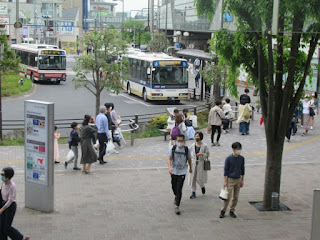A state of emergency was declared in Tokyo due to the resurge of COVID-19 infection. It became effective on April 25, 2021 (today).
This is the third emergency declaration following the April-May period in 2020 and the January-March period in 2021.
I
had a walk for exercise around my house in western Tokyo.
Some shops and restaurants were closed in the local shopping areas.
Most coffee shops offered take-away services only.
The public library offered only limited services.
Some shops, however, are open midnight (Such shops as grocery store are allowed to do so)
I found many people walking in the streets. There were as many people as there had been in the previous days, I observed. This is a scene at Kyodo, western Tokyo.
A year ago, when the first state of emergency was declares, the reactions of the people were different. Many people refrained from going out.
The towns were almost empty. the photo is the scene of underground walkways at Tokyo Station on April 7, 2020.
What happened in a year?
There are no compulsory orders to ban going out in the emergency declaration in Japan. People are only “asked” not to go out for unnecessary matters.
People followed positively to the request a year ago. Then, such requests have been repeated for about a year without showing clear effectiveness. Now, people are less cooperative to the govt.'s requests to stay home – this is what today’s scenes tell, it seems.
The number of confirmed cases of COVID-19 is not big in Japan (number of cases per population is about a tenth compared with those in the European countries and U.S.). Still, the number of the beds for the COVID-19 patients are limited. The pace of vaccination is very slow.
Prime Minister Suga explained in the press conference on April 23 that the state of emergency will continue till May 11. However, the terms were postponed from the original plans in the previous two cases. PM repeated to hold the Olympic and Paralympic Games from July 23. He did not answer directly to several questions from the press.









































